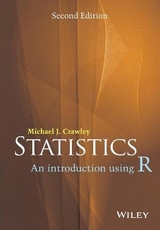
Statistics
An Introduction Using R
Seiten
2005
John Wiley & Sons Ltd (Verlag)
978-0-470-02297-9 (ISBN)
John Wiley & Sons Ltd (Verlag)
978-0-470-02297-9 (ISBN)
- Titel erscheint in neuer Auflage
- Artikel merken
Zu diesem Artikel existiert eine Nachauflage
R is one of the most powerful and flexible statistical software packages available. This is an introductory textbook to statistical analysis using the software. It covers a range of statistical techniques, including elementary material like t tests and chi squared tests, and intermediate methods like regression and analysis of variance.
Computer software is an essential tool for many statistical modelling and data analysis techniques, aiding in the implementation of large data sets in order to obtain useful results. R is one of the most powerful and flexible statistical software packages available, and enables the user to apply a wide variety of statistical methods ranging from simple regression to generalized linear modelling. "Statistics: An Introduction using R" is a clear and concise introductory textbook to statistical analysis using this powerful and free software, and follows on from the success of the author's previous best selling title "Statistical Computing". It features step by step instructions that assume no mathematics, statistics or programming background, helping the non statistician to fully understand the methodology. It uses a series of realistic examples, developing step wise from the simplest cases, with the emphasis on checking the assumptions (e.g. constancy of variance and normality of errors) and the adequacy of the model chosen to fit the data. The emphasis throughout is on estimation of effect sizes and confidence intervals, rather than on hypothesis testing.
It covers the full range of statistical techniques likely to be need to analyse the data from research projects, including elementary material like t tests and chi squared tests, intermediate methods like regression and analysis of variance, and more advanced techniques like generalized linear modelling. It includes numerous worked examples and exercises within each chapter. It is accompanied by a website featuring worked examples, data sets, exercises and solutions. "Statistics: An Introduction using R" is the first text to offer such a concise introduction to a broad array of statistical methods, at a level that is elementary enough to appeal to a broad range of disciplines. It is primarily aimed at undergraduate students in medicine, engineering, economics and biology but will also appeal to postgraduates who have not previously covered this area, or wish to switch to using R.
Computer software is an essential tool for many statistical modelling and data analysis techniques, aiding in the implementation of large data sets in order to obtain useful results. R is one of the most powerful and flexible statistical software packages available, and enables the user to apply a wide variety of statistical methods ranging from simple regression to generalized linear modelling. "Statistics: An Introduction using R" is a clear and concise introductory textbook to statistical analysis using this powerful and free software, and follows on from the success of the author's previous best selling title "Statistical Computing". It features step by step instructions that assume no mathematics, statistics or programming background, helping the non statistician to fully understand the methodology. It uses a series of realistic examples, developing step wise from the simplest cases, with the emphasis on checking the assumptions (e.g. constancy of variance and normality of errors) and the adequacy of the model chosen to fit the data. The emphasis throughout is on estimation of effect sizes and confidence intervals, rather than on hypothesis testing.
It covers the full range of statistical techniques likely to be need to analyse the data from research projects, including elementary material like t tests and chi squared tests, intermediate methods like regression and analysis of variance, and more advanced techniques like generalized linear modelling. It includes numerous worked examples and exercises within each chapter. It is accompanied by a website featuring worked examples, data sets, exercises and solutions. "Statistics: An Introduction using R" is the first text to offer such a concise introduction to a broad array of statistical methods, at a level that is elementary enough to appeal to a broad range of disciplines. It is primarily aimed at undergraduate students in medicine, engineering, economics and biology but will also appeal to postgraduates who have not previously covered this area, or wish to switch to using R.
Preface. Chapter 1 Fundamentals. Chapter 2 Dataframes. Chapter 3 Central Tendency. Chapter 4 Variance. Chapter 5 Single Samples. Chapter 6 Two Samples. Chapter 7 Statistical Modelling. Chapter 8 Regression. Chapter 9 Analysis of Variance. Chapter 10 Analysis of Covariance. Chapter 11 Multiple Regression. Chapter 12 Contrasts. Chapter 13 Count Data. Chapter 14 Proportion Data. Chapter 15 Death and Failure Data. Chapter 16 Binary Response Variable. Appendix 1: Fundamentals of the R Language.
| Erscheint lt. Verlag | 11.3.2005 |
|---|---|
| Zusatzinfo | Illustrations |
| Verlagsort | Chichester |
| Sprache | englisch |
| Maße | 179 x 254 mm |
| Gewicht | 746 g |
| Einbandart | gebunden |
| Themenwelt | Mathematik / Informatik ► Mathematik ► Statistik |
| Mathematik / Informatik ► Mathematik ► Wahrscheinlichkeit / Kombinatorik | |
| ISBN-10 | 0-470-02297-3 / 0470022973 |
| ISBN-13 | 978-0-470-02297-9 / 9780470022979 |
| Zustand | Neuware |
| Informationen gemäß Produktsicherheitsverordnung (GPSR) | |
| Haben Sie eine Frage zum Produkt? |
Mehr entdecken
aus dem Bereich
aus dem Bereich
Eine Einführung für Wirtschafts- und Sozialwissenschaftler
Buch | Softcover (2022)
De Gruyter Oldenbourg (Verlag)
CHF 41,90



